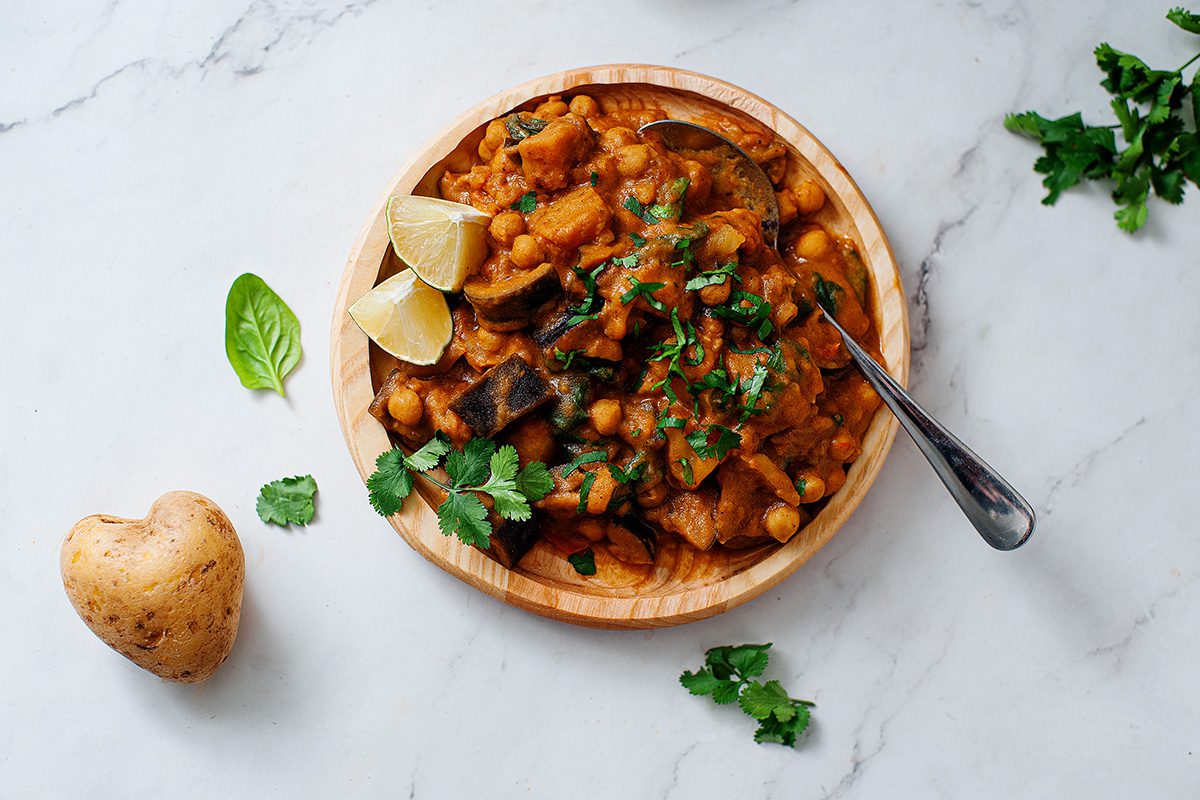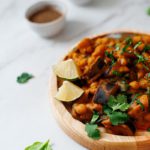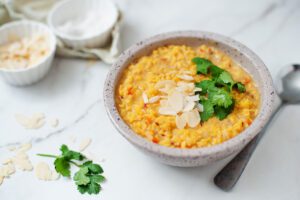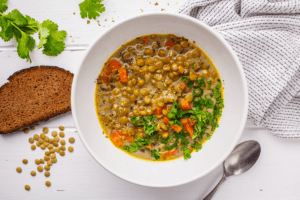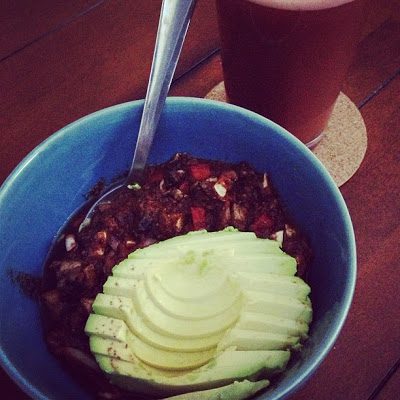The first time I ever had Aloo Baingan (potato eggplant curry) was in India with a buttery slice of naan 🤤
Ever since, I’ve been exploring different Indian recipes that I tasted while there.
This Aloo Baingan recipe (AKA eggplant and potato curry) is my own version based on my understanding and available ingredients. I encourage you to explore this recipe and its origins before beginning!
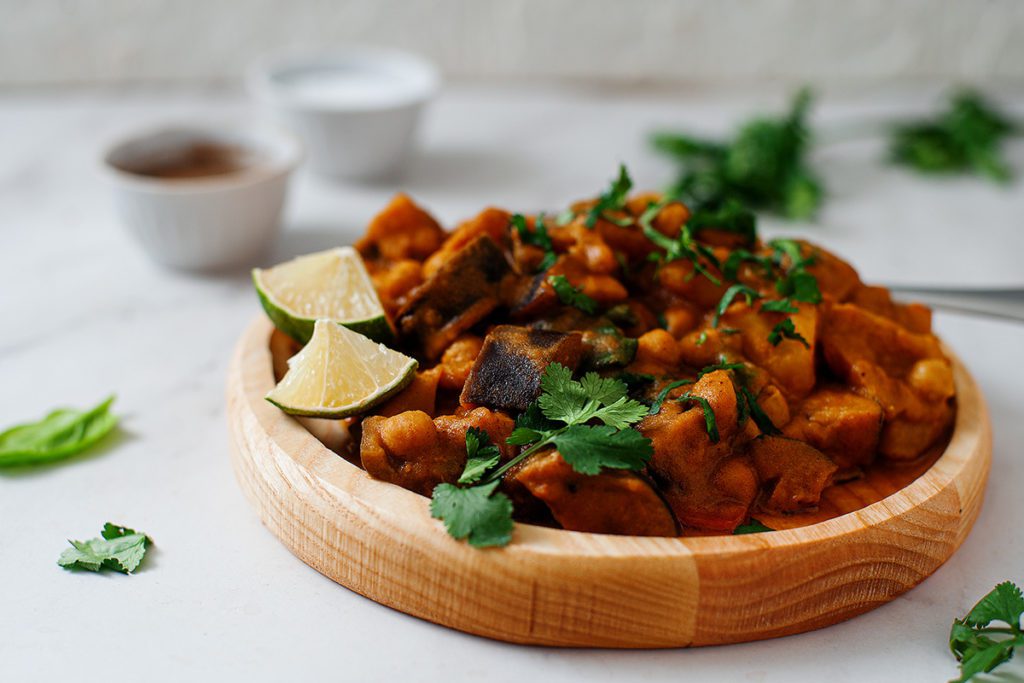

What Is Aloo Baingan’s Back Story?
Aloo Baingan, a delightful blend of potatoes (Aloo) and eggplants (Baingan), is a classic dish that hails from the diverse and rich culinary landscape of India. This dish is a staple in many Indian households and is particularly popular in the northern regions of the country. The beauty of this Aloo Baingan recipe lies in its simplicity and the harmonious symphony of flavors created by the melding of humble ingredients with aromatic spices.
The cultural significance of Aloo Baingan is deeply rooted in the Indian tradition of vegetarianism. In India, a large portion of the population follows a vegetarian diet due to religious, cultural, and personal reasons. Eggplant and potatoes, being widely available and affordable, form the backbone of many vegetarian dishes, including Aloo Baingan. This dish is not just a testament to the Indian ethos of simplicity and frugality, but it also showcases the magic that Indian spices can create even with the most basic ingredients.
Why You’ll Love This Eggplant and Potato Curry
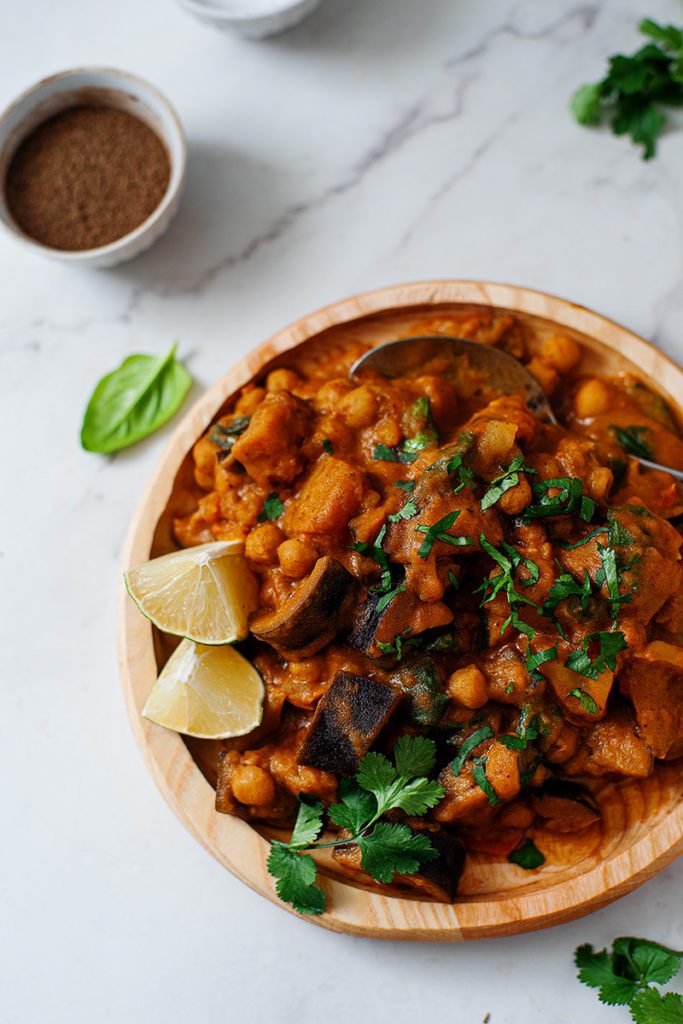

This Eggplant and Potato Curry is a dish that will make your taste buds dance with joy. It’s a symphony of flavors that come together to create a meal that’s both comforting and exciting. Here’s why you’ll fall in love with this dish:
- Unique and Authentic: This isn’t your everyday curry. It’s a recipe that draws inspiration from traditional Indian cuisine, specifically the popular Aloo Baingan. But it’s been given a unique twist, making it a standout dish that you won’t find in your average cookbook or food blog.
- Flavorful and Rich: The combination of eggplant and potato in this curry creates a rich and hearty base. The eggplant, with its unique, slightly sweet flavor, pairs perfectly with the earthy taste of the potatoes. The spices, including turmeric, cumin, and coriander, add depth and complexity to the dish, making each bite a flavorful explosion.
- Varied Textures: This curry offers a delightful mix of textures. The eggplant becomes incredibly tender as it cooks, almost melting into the sauce, while the potatoes retain a bit of their firmness, providing a satisfying bite. The result is a dish that’s as interesting texturally as it is tasty.
- Health Benefits: This curry is not just delicious, it’s also packed with nutrients. Eggplant is a great source of dietary fiber, vitamin B1, and copper. It’s also rich in manganese, a mineral that’s essential for the function of many enzymes in the body. Potatoes, on the other hand, are a good source of vitamin C, vitamin B6, and potassium. They also contain a variety of phytonutrients that have antioxidant activity.
- Easy to Make: Despite its complex flavors, this curry is surprisingly easy to make. It’s a one-pot dish that requires minimal prep work. Plus, it’s a great way to use up any leftover potatoes or eggplants you have lying around.
So, whether you’re a curry connoisseur or a newbie to Indian cuisine, this Eggplant and Potato Curry is a dish that’s sure to impress. It’s a feast for the senses that you’ll want to make again and again.
Ingredients for Aloo Baingan (Potato Eggplant Curry)
When it comes to creating a flavorful and satisfying Aloo Baingan, or potato eggplant curry, the ingredients you choose can make all the difference. Here’s a detailed list of what you’ll need, along with some handy substitutions and explanations of how each ingredient contributes to the dish.
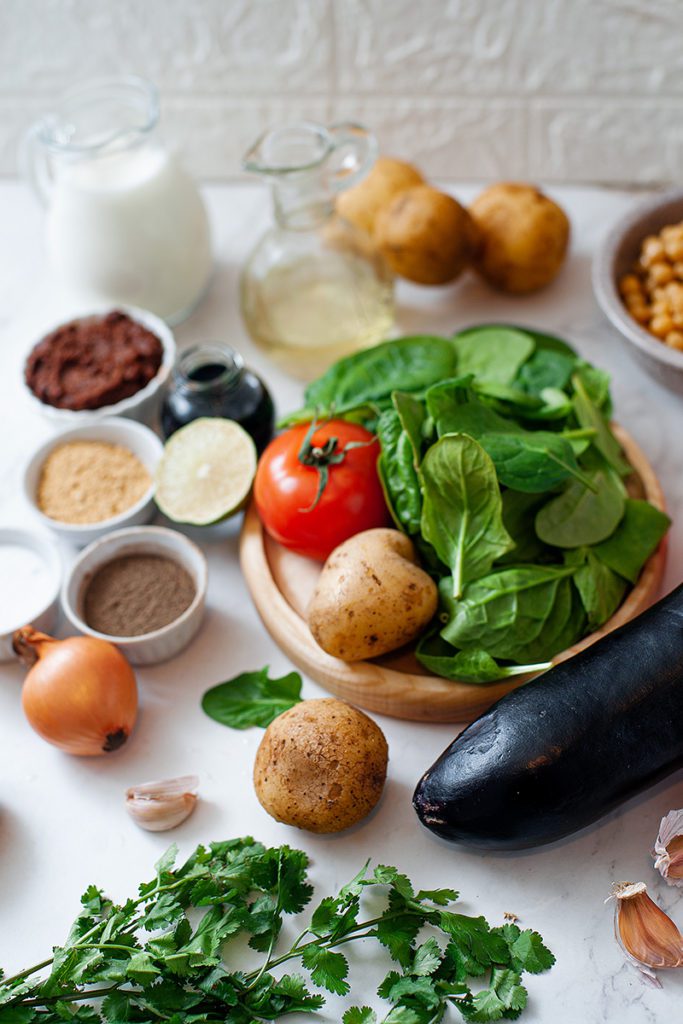

- Eggplant (Baingan): The star of the show, eggplant brings a unique, slightly sweet flavor and a creamy texture to the curry. If you can’t find regular eggplants, you can substitute them with Japanese or Chinese eggplants.
- Potatoes (Aloo): Potatoes add a hearty, comforting element to the curry. They absorb the flavors of the curry well, making every bite a delight. Any variety of potato works well in this dish, but Yukon Gold or Russet potatoes are particularly good choices.
- Olive Oil: This is used for sautéing the vegetables and spices. You can substitute it with other cooking oils like canola or sunflower oil if you prefer.
- Onion, Garlic, and Ginger: These three ingredients form the aromatic base of the curry, providing a depth of flavor that is quintessential to Indian cuisine. If fresh ginger is not available, ground ginger can be used instead.
- Curry Paste: This is where the heat comes in. Our curry paste is homemade and includes a variety of spices like coriander, cumin, and mustard seeds, among others. If you’re short on time, a store-bought curry paste can be used instead.
- Coconut Milk: This adds a rich, creamy texture to the curry and balances out the heat from the spices. If you’re not a fan of coconut, you can use yogurt or heavy cream as a substitute.
- Tomatoes: Fresh tomatoes add a tangy flavor that compliments the creaminess of the coconut milk. In a pinch, canned tomatoes can be used instead.
- Chickpeas: These add a boost of protein and fiber to the curry, making it even more filling. If you’re not a fan of chickpeas, you can substitute them with other legumes like lentils or peas.
- Lime Juice and Soy Sauce: These ingredients add a bit of tang and umami flavor to the curry, enhancing the overall flavor profile. If you don’t have soy sauce, tamari or even a bit of salt can be used instead.
- Spinach: This leafy green adds a pop of color and a dose of nutrients to the curry. Feel free to substitute it with other greens like kale or Swiss chard.
- Cilantro: Used as a garnish, cilantro adds a fresh, herby flavor that rounds out the dish. If you’re one of those people who find cilantro to taste like soap, fresh parsley is a great alternative.
How to Make Potato Eggplant Curry
First, begin by making the curry seasoning. Put the coriander seeds, cumin seeds, mustard seeds, fennel seeds, curry leaves, and peppercorns into a dry frying pan over a medium heat. Cook for about three minutes, stirring often, until the mustard seeds start to pop and the seeds turn golden and aromatic. Tip into a bowl and allow to cool for a few minutes.
Add the turmeric, cinnamon, paprika and dried green chili to a pestle and mortar. Add the cooled toasted spices and grind everything together into a fine powder. Add the salt.
Add grated ginger, garlic, tomato purée and white wine vinegar and mix well to make a paste.
Use immediately, or spoon the paste into a jar, cover with a layer of oil, seal with a lid and store in the fridge for up to a week. This is how I save mine and use the paste when cooking, like in this curry recipe.
To begin making the curry, heat the oil in a large saucepan, add the onion, garlic and diced potatoes. Cook covered over a low heat for 5 minutes until the potatoes start to soften.
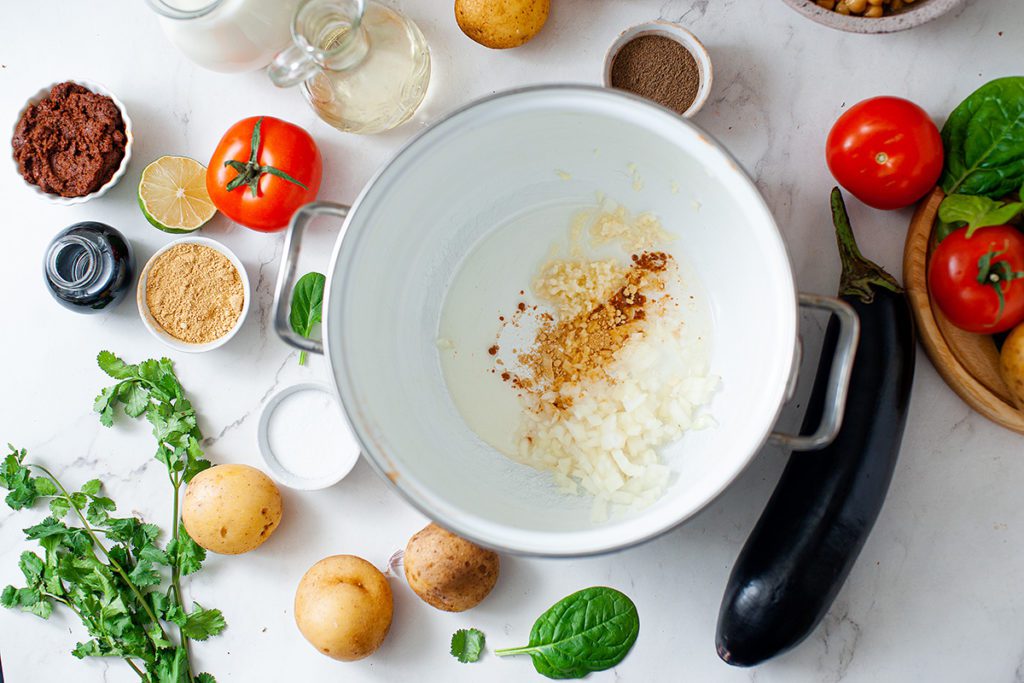

Throw in the chopped eggplant and curry paste, then cook covered for a few more minutes.
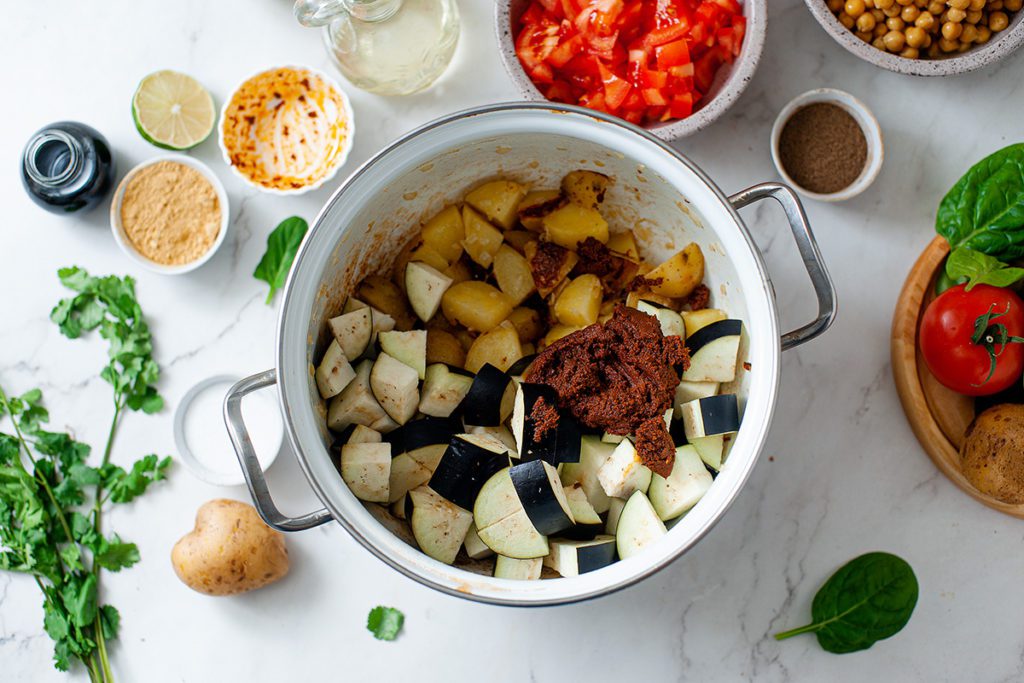

Pour the water (or coconut milk) and chopped tomatoes into the pot. Stir it up so everything is well combined. Boil and cook for 5 minutes.
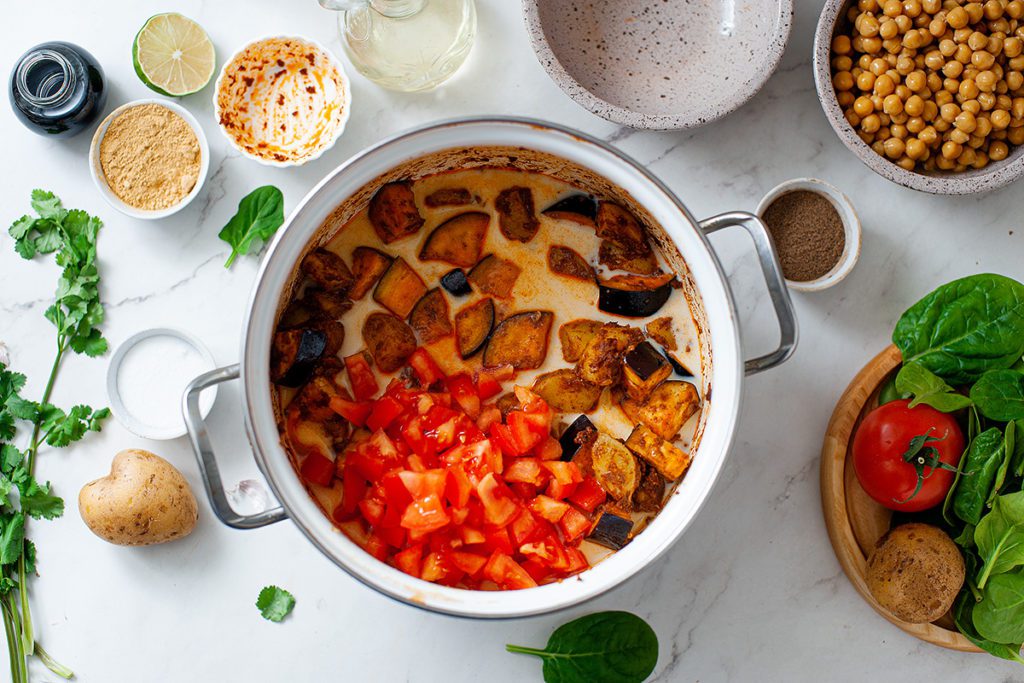

Add the chickpeas to the pot and let simmer on medium heat until fully cooked.
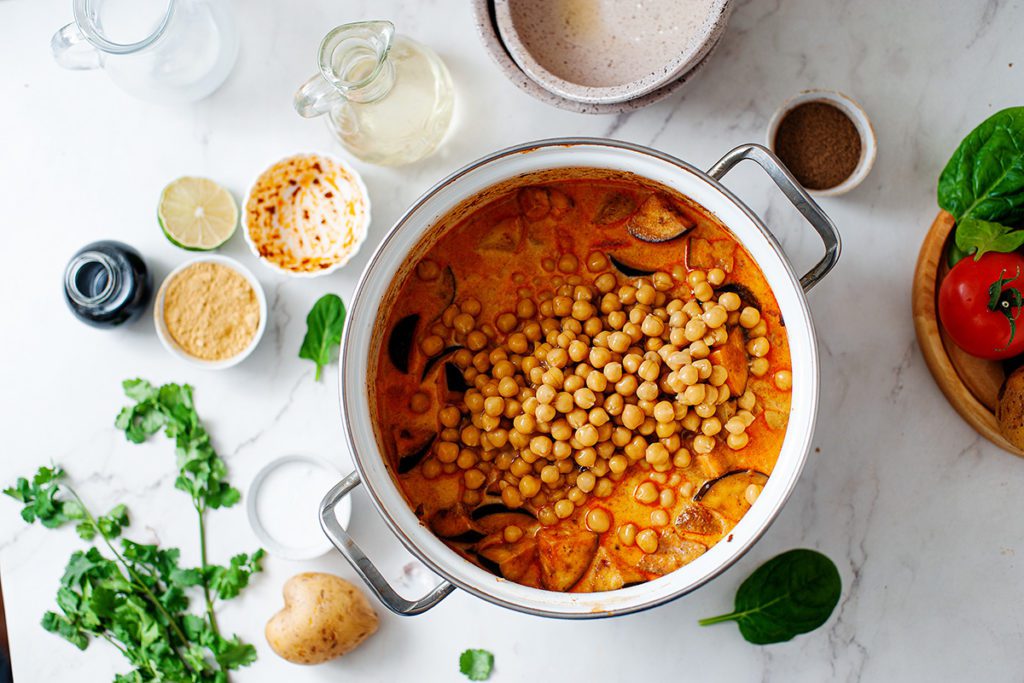

Add the lime juice and soy sauce, followed by the spinach. Stir and cook until the spinach is wilted. Serve hot with fresh cilantro leaves, garam masala, and lime wedges.
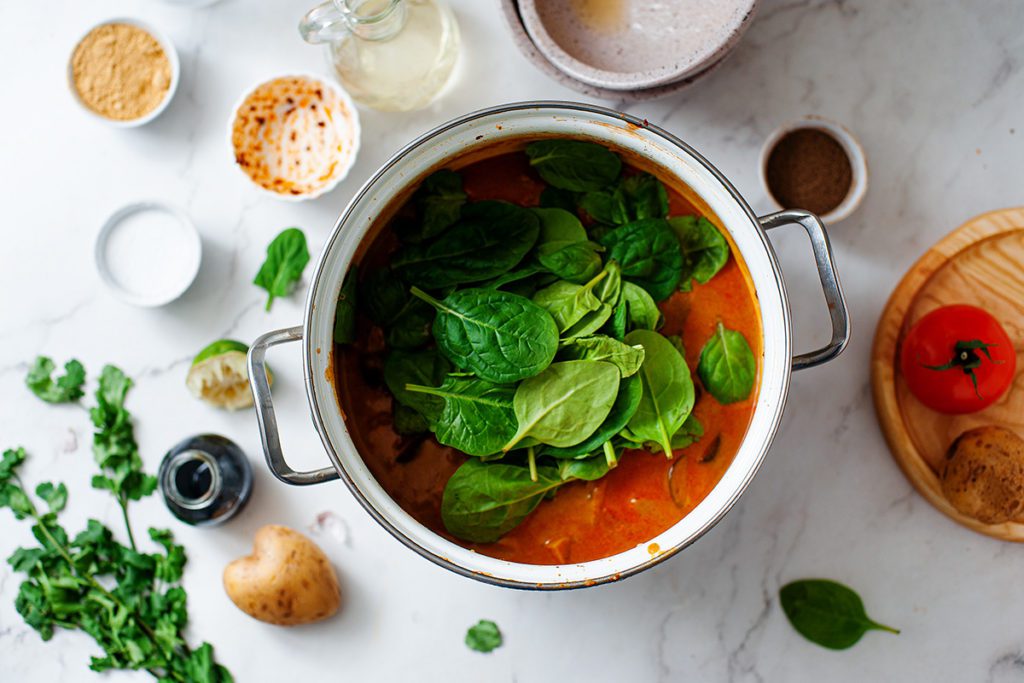

Tips and Tricks for the Perfect Eggplant Potato Curry
When it comes to making a delicious potato eggplant curry, a few insider tips can make all the difference. Here are some tried-and-true suggestions to help you create a full eggplant potato curry that’s bursting with flavor:
- Choose Your Eggplant Wisely: Smaller eggplants tend to be less bitter and have fewer seeds. If you can find baby eggplants, they offer a sweeter taste and softer texture. Remember, if your eggplant turns out to be a bit bitter, a small amount of sugar can help balance the flavors.
- Prevent Browning: After cutting your eggplant, keep the pieces in water until you’re ready to use them. This simple trick prevents the eggplant from turning brown.
- Potato Alternatives: While traditional potatoes work great, don’t be afraid to switch things up. Sweet potato or red potato can be a delicious alternative.
- Boost the Flavor: A squeeze of fresh lemon juice or a bit of garam masala added at the end can really enhance the flavors of your curry. If you’re looking for a more authentic flavor, consider cooking with mustard oil.
- Avoid a Sticky Situation: If your curry is sticking to the pan, don’t panic. A splash of water can solve the problem.
- Cooking Methods: If you’re using a pressure cooker or Instant Pot, cut the eggplant into larger pieces to prevent them from becoming mushy. For a smoky flavor, try roasting the eggplant on direct flame or in the oven.
- Add More Veggies: Feel free to add other vegetables like bell peppers, carrots, or peas to your curry. They’ll add extra nutrition and taste.
- Coconut Milk: Coconut milk is most often used in Southeast Asian curries and South Indian curries. I like making my curries extra spicy and throwing a can of coconut milk in for a rich curry. This probably isn’t very traditional but I like it!
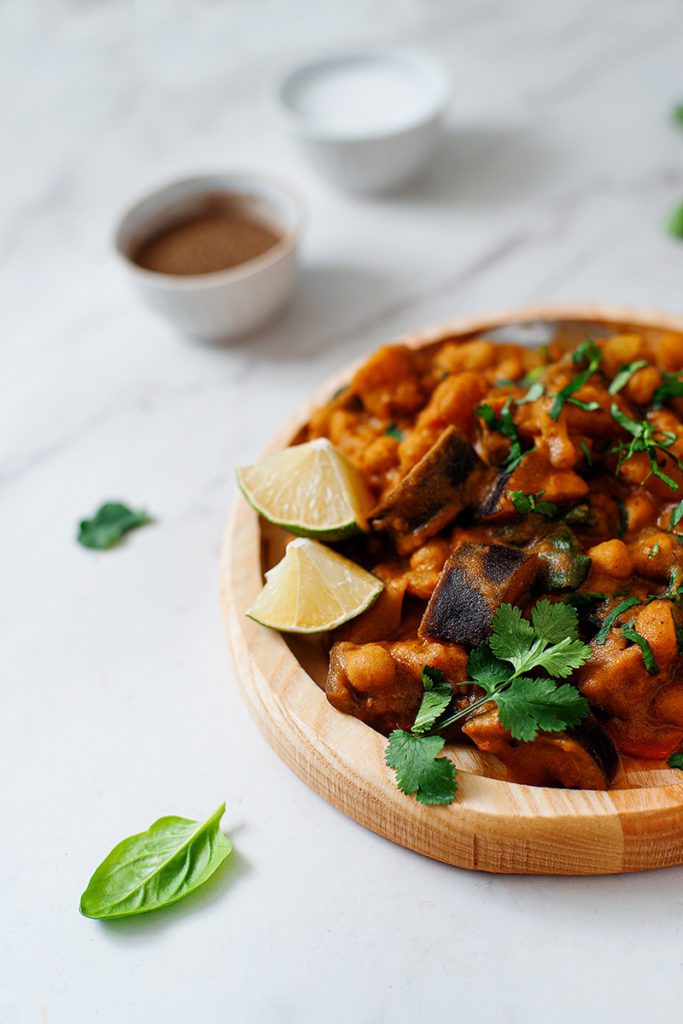

Variations of Potato and Eggplant Curry Recipe
If there’s one thing I love about cooking, it’s the endless possibilities for creativity and personalization. This eggplant potato curry is no exception. While the aloo baingan recipe I’ve shared with you is a personal favorite, there are countless ways to tweak it to suit your own taste buds or dietary needs.
Let’s explore a few variations that you might find interesting.
- South Indian Style Curry: If you’re a fan of South Indian cuisine or simply want to add a creamy, rich texture to your curry, try incorporating coconut milk. Replace the water in the recipe with an equal amount of coconut milk. This not only adds a deliciously creamy texture but also imparts a subtle sweetness that beautifully balances the spices.
- For the Spice Lovers: If you’re like me and love a good kick of heat in your curry, feel free to add more dried chillies to the curry paste or sprinkle some red pepper flakes on top before serving.
- Low-Fat Version: If you’re watching your fat intake, you can easily modify this recipe. Simply replace the olive oil with a low-fat cooking spray or use a non-stick pan. You could also replace the coconut milk (if you’re using it) with a low-fat version or with vegetable broth.
- Gluten-Free Option: This curry is naturally vegan and gluten-free, but always make sure to check the labels of your soy sauce and curry paste to ensure they don’t contain any hidden gluten.
Potato Eggplant Curry
Equipment
- Instant Pot (if choosing a quicker version)
Ingredients
Curry Paste
- 3 Tbsp coriander seeds
- 2 Tbsp cumin seeds
- 1 Tbsp mustard seeds
- 1 tsp fennel seeds
- 1 tsp black peppercorns
- 1-3 curry leaves
- 1 tsp turmeric powder
- 1 tsp cinnamon powder
- 1 tsp paprika
- 1-2 dried green chilies depending on personal preference
- 1 tsp sea salt
- 1 inch ginger root finely grated
- 4 garlic cloves finely grated
- 1 Tbsp tomato puree
- 4 Tbsp white wine vinegar
- vegetable or sunflower oil to cover the paste for storing
Eggplant Potato Curry
- 1 eggplant
- 4-5 small potatoes
- 3 Tbsp extra virgin olive oil
- 1 small onion
- 3 garlic cloves
- 3 Tbsp curry paste** (**recipe above)
- 2 cups coconut milk
- 2-3 tomatoes
- 1 can chickpeas (optional)
- 1/2 lime juiced
- 1 Tbsp soy sauce
- 5 cups fresh spinach (optional)
- fresh cilantro for serving
Instructions
Curry Paste
- Put the coriander seeds, cumin seeds, mustard seeds, fennel seeds, curry leaves, and peppercorns into a dry frying pan over a medium heat. Cook for about three minutes, stirring often, until the mustard seeds start to pop and the seeds turn golden and aromatic. Tip into a bowl and allow to cool for a few minutes.
- Add the turmeric, cinnamon, paprika and dried green chili to a pestle and mortar.
- Add the cooled toasted spices and grind everything together into a fine powder. Add the salt.
- Add grated ginger, garlic, tomato purée and white wine vinegar and mix well to make a paste.
- Use immediately, or spoon the paste into a jar, cover with a layer of oil, seal with a lid and store in the fridge for up to a week.
Potato Eggplant Curry
- Heat the oil in a large saucepan, add the onion, garlic and diced potatoes. Cook covered over a low heat for 5 minutes until the potatoes start to soften.
- Throw in the chopped eggplant and curry paste, then cook covered for a few more minutes.
- Pour the coconut milk and chopped tomatoes into the pot. Stir it up so everything is well combined. Boil and cook for 5 minutes.
- Add the chickpeas to the pot and let simmer on medium heat until fully cooked.
- Add the lime juice and soy sauce, followed by the spinach.
- Stir and cook until the spinach is wilted.
- Serve hot with fresh cilantro leaves, garam masala, and lime wedges.
Frequently Asked Questions
Can I make this curry in advance?
Absolutely! One of the great things about this eggplant potato curry is that it’s a dish that tastes even better the next day. The flavors have more time to meld together, creating a more robust and flavorful curry. Just make sure to let it cool completely before storing it in an airtight container in the fridge.
How long does this curry last in the fridge?
Eggplant curries will last for about 4-5 days in the fridge when stored properly. Make sure to keep it in an airtight container to maintain its freshness. It’s also important to note that the curry may thicken as it sits, so you might need to add a little water when reheating.
Can I freeze this curry?
Yes, you can! This Eggplant and Potato Curry freezes beautifully. Once cooled, place it in a freezer-safe container or heavy-duty freezer bags. It can be frozen for up to 2 months. To reheat, thaw it in the fridge overnight and then warm it up on the stove, adding a bit of water if necessary to thin it out.
What can I serve with this curry?
This curry is quite versatile when it comes to serving options. It pairs well with basmati rice or naan bread for a traditional Indian meal. You can also serve it with quinoa or couscous for a healthy, whole grain addition. If you’re looking for a low-carb option, cauliflower rice would work well too. Add a side of yogurt or raita to balance the heat!
How can I cook this in an Instant Pot?
If you’re a fan of the Instant Pot method, you’ll be pleased to know that this Eggplant and Potato Curry can easily be adapted for this handy kitchen gadget. Start by setting your Instant Pot to the sauté mode and heat the oil. Add the onion, garlic, and ginger, and sauté until fragrant. Then, add the potatoes, eggplant, and curry paste, stirring well to combine. Pour in the water or coconut milk, tomatoes, and chickpeas, ensuring that everything is well mixed. Secure the lid of the Instant Pot and set it to manual high and pressure cook for 5 minutes. Once the pressure cooking time is up, allow the pressure to release naturally for 10 minutes, then perform a quick release for any remaining pressure. Stir in the lime juice, soy sauce, and spinach, allowing the heat from the curry to wilt the spinach.
